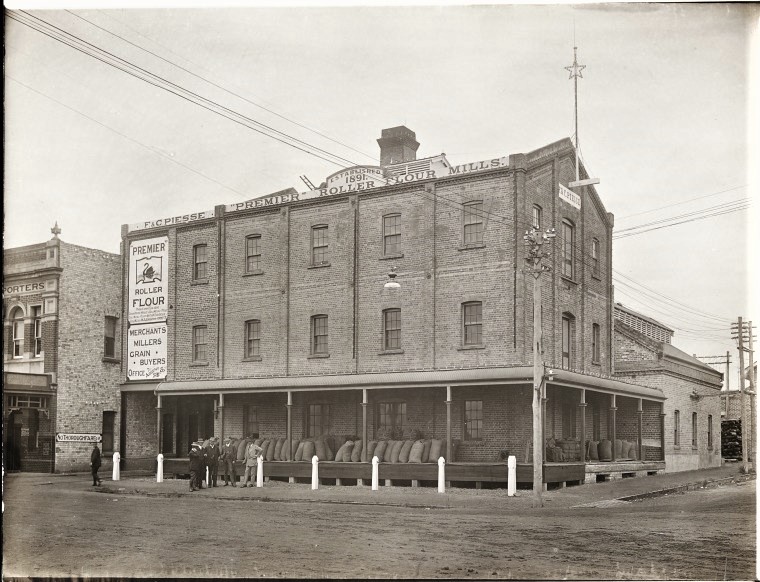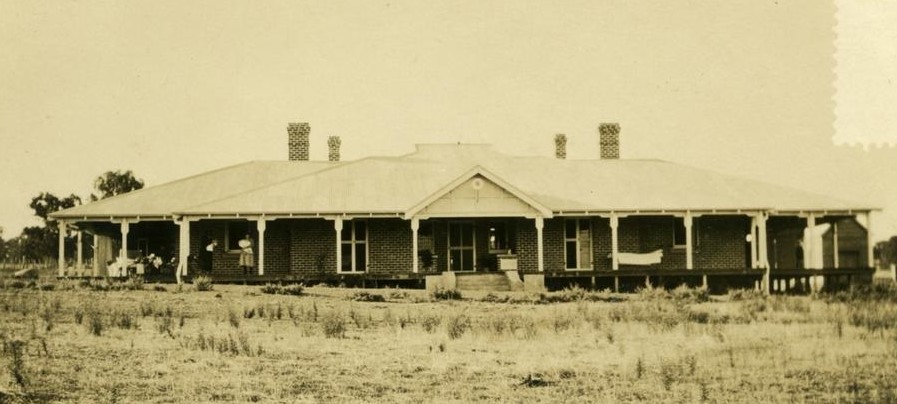Progress.
PROGRESS OF KATANNING
& THE GREAT SOUTHERN
RURAL GOSSIP.
NOTES AND COMMENTS.
Western Mail
23 November 1922 – P2
Progress on the Great Southern.
(By “Canmore.”)
While visiting Katanning recently I was afforded a good opportunity of seeing something of the wonderful progress made in recent years in these earlier settled districts of the Great Southern, and, when one looks at big thriving towns like Katanning and Wagin, the influence of individual families on this development will be recognised.
The late Messrs. F. and C. Piesse did much in laying the foundations for the trade, industry and general production of these two districts, and the members of their families are carrying on the good work.
Everybody in the Katanning district knows Mr. Harold Piesse, and as he also knows everybody. I was fortunate in having his guidance and agreeable company. The district, of which Katanning is the centre, embraces an area of country exceeding 10,000 square miles, in which are the thriving townships of’ Kojonup; Woodanilling, Nyabing, Badgebup, Broomehill, Gnowangerup, Ongerup, Tambellup and Cranbrook, and the population of 12,000 is rapidly increasing. Nearly four million acres in the district have been purchased by the Crown, of which 550,000 acres have been brought under cultivation, and 900,000 acres are in course of preparation for the plough. The harvest for the1920-21 season included 682,738 bushels of wheat, 412,162 bushells of oats, 10,000 bushels of barley and 27,676 tons of hay, whilst nearly 32,000 acres carried fodder crops.
The wool output totalled over four million pounds in weight, and the livestock statistics for the district show that this area of country accounts for 14,329 horses, 9,127 cattle, 659,943 sheep, and 3,531 pigs. lt will be seen from these figures that the district is highly productive now, but, when many of the farmers in the district improve their methods of working the land, the position will be greatly improved. The soil over a big range of this country is suitable for any class of production, and, with a rainfall that varies from 24 inches in the western and southern portions to 18 ” inches in the eastern areas, great things should be possible.
A Very Prosperous Town.
The town of Katanning has a population of over 2,300, is electrically lighted, and has its own water supply. The municipal buildings cost £6,000, the four bank buildings £10,000, the Katanning Club £4,000, and the Premier Flour Mill, with its huge wheat silos, £83,000. Then there are three fine hotels, a hostel, a restaurant and two coffee palaces, besides many beautiful homes. At the palatial residence of the late Mr. F. H. Piesse a Church of England Girls’ School has been established, which has accommodation for 63 boarders, and these children come chiefly from the goldfields and the metropolitan area. The town is expanding very rapidly, and this is having the effect of enhancing values to such an extent that property owners on the outskirts of the boundaries have recently subdivided some of their cultivation paddocks into five and ten acre blocks ,and these were sold rapidly by Mr. Harold Piesse at prices ranging from £22 to £29 an acre.
Premier Roller Flour Mill c1920
The majority of these small holdings have been taken up by the numerous merino stud breeders in the district, and they are very convenient for depasturing for a few days any sheep intended for show or sale. This strikes me as a very wise provision, as the sheep are displayed in presentable condition after having thrown off the traces of travel.
A Motor Run to Kojonup.
A lot of property has changed hands recently in the Katanning district, some of which has been brought under closer settlement, and other owners of larger estates appear to be making considerable effort to bring a greater portion of their land into more profitable use.
This was particularly noticeable at the Indinup Estate; the 10,000 acres which was taken up by the late Mr. W. Grover about .five miles out from Katanning on the Kojonup Road. This fine property is managed by Mrs. Graham, a daughter, who is regarded as one of the most practical women in Western Australia; and under her management the property is developing into one of the best estates in the district. Clearing is proceeding at the rate of 600 acres a year. Old Mrs. Grover, who has been a resident of the district for 70 years, is still, living.
On the left of the road near this point is “Wattle Park,” a property of 6,000 acres, which was recently acquired by Mr. Charles Rischbieth, of Adelaide, and improvement is also being effected here. Close to this again is the Carrolup Native Reservation, but recently the native residents have been removed to Mogumber, and there is some amount of controversy going on in the district at the present time in regard to the possibility of this country being thrown open for selection.
Some favour the subdivision of the 10,000 acres, while other residents are opposing this scheme, and it seems to be a matter for very careful consideration before any action be taken. Good examples of successful farming on small holdings are supplied by Mr. Cyril Tree, who is located on a 800 acre block, and Mr. Walter Longmore. The latter has been one of the most successful farmers in the district, and recently purchased 300 acres on the outskirts of Katanning, on which he intends to retire. A near neighbour is Mr. J. F. Ladyman, a practical farmer from South Australia, who is a leading light with the Country Party in the district; and lying back to the left of the road, and adjoining the property of his brother-in-law, Mr. Barrie Wood, is the home of Mr. Cliff Anderson, a young merino breeder, who has one of the best studs in the Great Southern districts. Mr. Henry Ladyman, who had five sons on active service during the recent war, lives a little further down the road, and, to show his faith in the neighbourhood, he has settled all his sons on the land in the Katanning district.
Some of the small farms in this locality are well modelled and excellently kept, and the fact of some of the owners being in a position to run their own motor cars is sufficient evidence of the productiveness of this land. A little further on the farm which was occupied by Mr. Werner has recently been taken over by two returned soldiers, and their sheep appeared to be in good condition. While close at hand Mr. Tup Ladyman is now in occupation at Hope Farm, a property previously owned by Mr. H. V. Piesse. At Mr. Lowrance’s farm we passed a good paddock of rape and oats, and I was informed he carries more sheep to the acre than any other farmer in the district. This is not a big farm, but, through his industry and sound judgment, Mr. Lawrance has carried out a lot of valuable improvement entirely off his own bat.
What Brains and Industry Can Do.
On the right of the road is the farm of Messrs. Perkins Bros., two young Englishmen who came to this State about 12 years ago. One had been a bootmaker and the other a bricklayer, and they had absolutely no experience of agricultural work. Today they own nearly 5,000 acres of land, which is free from debt. This is a fine example of what can be accomplished with brains and industry, as their country was not first class when selected, but it will compare very favourably with anything on the Kojonup Road now. This year they shore about 50 bales of wool, besides cropping a lot of oats and wheat, and they did it with their own labour.
On the left of the road, near Messrs. Perkins Bros., Mr. James Wigglesworth recently sold his well-appointed farm of 4,000 acres, and this is adjacent to the property of Messrs. Bignell Bros., very successful farmers, who have recently taken up a big poison area below Kojonup, lt is predicted that they are certain to make good on this owing to their exceptional knowledge of the district.
On the boundary of the pretty town of Kojonup is Quanandup, an exceptionally fertile 1,200 acres owned by Mr. H. V. Piesse. This property comprises location 3, and was originally taken up by. Capt. Vanzuilecome, who was buried many years ago on the property. This farm, which is wonderfully rich and well watered, was selected over 80 years ago, and adjoins Glenlossie, which was owned by the late Mr. Thomas Chipper, who had the Albany mail contracts for many years. He was also the father of the late Mrs. F. H. Piesse. Mr. Harold Piesse informed me that last year he carried a sheep and a quarter to the acre all the year round, and, although they had only been off the paddocks for five weeks, it was impossible to see where they had been, as the whole of the country was covered with a dense mass of excellent feed. Last year in, places, the wild oats were so high that they were level with the hood of his motor car, and this was easy to realise after an inspection of his splendid oat crop. It is certainly one of the most prolific strips of pasture land I have seen in the State, and is beautifully situated among these picturesque hills.
People Who Help Themselves.
A lot is often said and written about the lack of conveniences and attractions in connection with rural life, but the position in the country would be greatly improved if the example set by the people of Kojonup was followed in other districts. Eighteen months ago it was decided that the town wanted a hospital, and the local residents got busy in rounding up the necessary capital. The sum of £2,014 was subscribed, and today, an eight-bed hospital is in full working order with Nurse Cartwright in charge. It is an exceptionally well constructed institution, and under its 12ft. verandah we inspected the first baby born on the premises. The main entrance faces the south, where the “Albany Doctor” blows in from during tine hot weather, and the rooms are lofty, and are lit with electricity. It was a fine effort on the part of the district to make this provision, and it is just one of those things that go a long way to make the country more attractive. Kojonup is now busy raising funds for a War Memorial Hall.
Kojonup Hospital in 1923
Progress. Progress. Progress. Progress. Progress. Progress.


